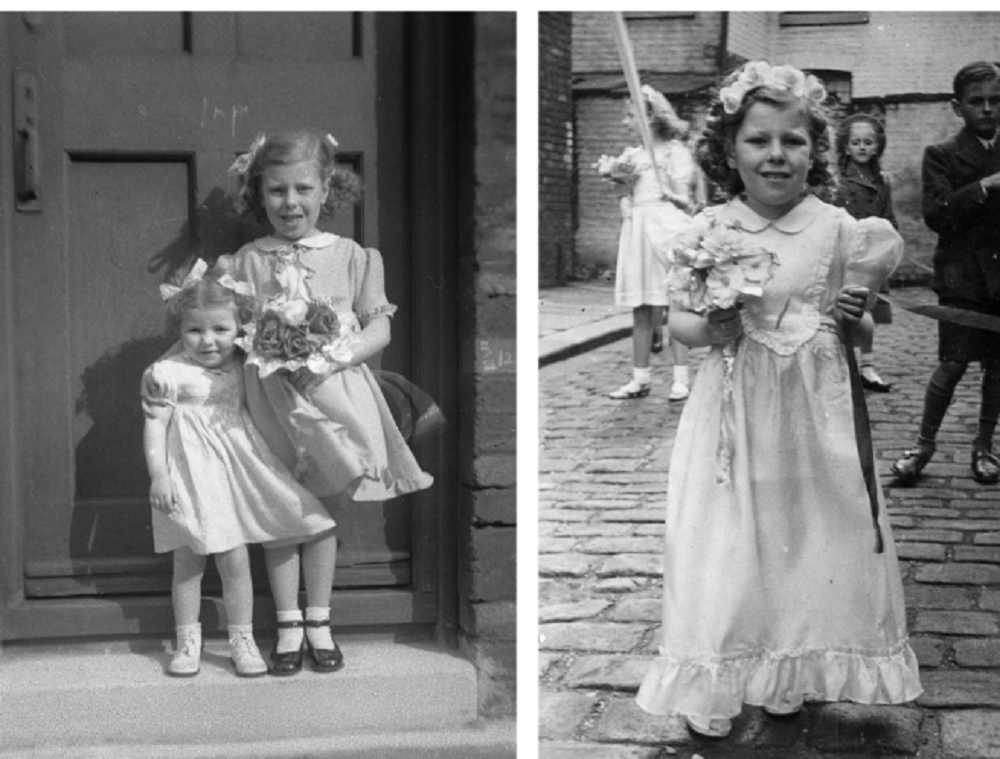Just like Molly dancing, our May queen was organised and performed by a fluid group of girls who played together in the street. It has little connection to organised events featuring Rose queens or intricate Maypole dancing, but it was a good excuse to dress up.
In the 1950s, fancy dress hire was unimaginable. Thankfully crepe paper was amazingly strong and versatile, if not actually colour fast in a sudden downpour.
The money earned by Molly dancing provided the wherewithal to ensure we were well turned out, but it was the older girls who passed on the May queen ’knowledge’ year by year.
The first of several decisions to be made was the choice of queen. Anyone in possession of a long dress was an automatic contender. That’s how I came to be queen in 1952. The previous year, tricked out in blue georgette, elbow length lace gloves and ringlets, I was my auntie’s bridesmaid at St. John’s, Ashley Lane.
The next important choice was the May queen’s attendants. Their duty was to hold the decorated garf (or garth) over the queen as she waited expectantly at each front door. A garf was a half circular hoop of anything that could be decorated with crepe paper flowers.
With the exception of the queen, everybody else would be dressed in a paper pinafore type garment with matching headgear. The final decision was which two colours would form that year’s theme. Some flexibility was necessary as it was possible the newsagent’s might not have enough crepe paper in either colour to satisfy our needs.
It was the older girls who did the cutting out, but we all had to sew our own outfits.
The main colour was used for the skirt section and the heart-shaped top of the pinafore. Colour 2 was cut into 3 or 4 inch wide strips for apron ties and the rosette style caps held on with hair clips. Some of the secondary colour was gathered into a frill and sewn around the heart shape bodice.
The Maypole consisted of a brush stale (broom handle) wrapped in some of the remaining crepe paper with the required number of ‘ribbons’ attached. It was usually the tallest girl who carried the Maypole while the rest held onto the streamers.
The favourite and most artistic task was sculpting the crepe paper into flower petals to be attached to the garf.
By the 1st of May, we were all set. The girls with the Maypole stood poised while the queen and her entourage approached each front door and knocked…
Crepe paper doesn’t stand up to being threaded and plaited like a real Maypole, so no actual dancing took place. To make up for the static nature of our display, we sang instead:-
“Around the merry maypole, and all the live long day,
We crown you [first and surname of the queen], we crown you queen of May.”
We sang several variations on the theme, but I’m sorry to say I have
forgotten the others.
Our reward for the efforts put into Molly and Maypole dancing was a ‘garden’ party. That is to say, a kitchen table covered with a cloth was set up in someone’s back garden.
The pennies and halfpennies collected by us bought the ingredients for the feast, and our mothers prepared it. Most foodstuffs were off ration by that time, so we were able to enjoy as many sandwiches, jellies and fancy cakes as our funds would stretch to.
We played games until it went dark, and I don’t remember a single occasion when our celebrations were rained off.
It’s 67 years since my debut as May queen, and I still remember it as one of the highpoints of my childhood. Modern day May Queen’s preparing for a ceremony in Failsworth in 2018
Modern day May Queen’s preparing for a ceremony in Failsworth in 2018
 May Day and Whitsun required the best dresses; perhaps the proceeds from Molly Dancing helped. Photo provided by Alan Hampson
May Day and Whitsun required the best dresses; perhaps the proceeds from Molly Dancing helped. Photo provided by Alan Hampson